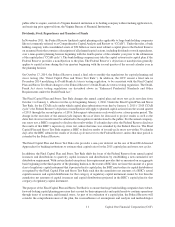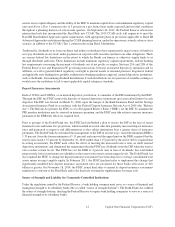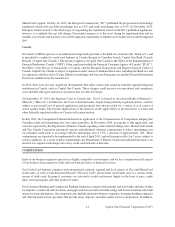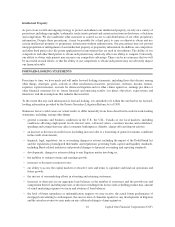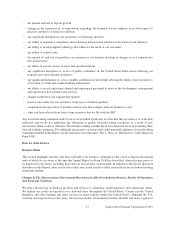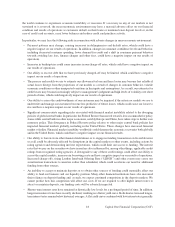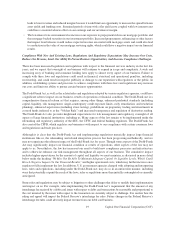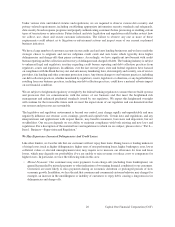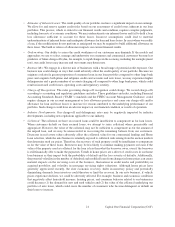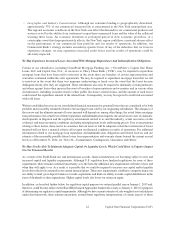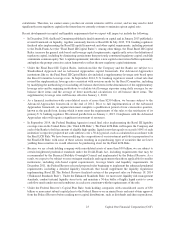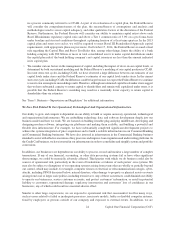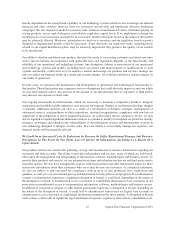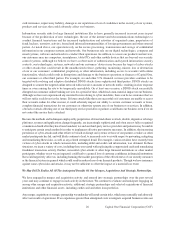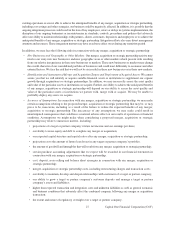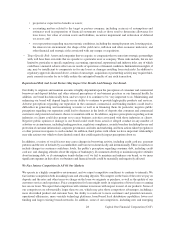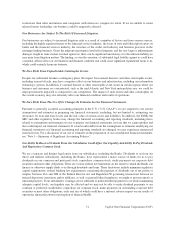Capital One 2014 Annual Report Download - page 43
Download and view the complete annual report
Please find page 43 of the 2014 Capital One annual report below. You can navigate through the pages in the report by either clicking on the pages listed below, or by using the keyword search tool below to find specific information within the annual report.•Estimates of Inherent Losses: The credit quality of our portfolio can have a significant impact on our earnings.
We allow for and reserve against credit risks based on our assessment of credit losses inherent in our loan
portfolios. This process, which is critical to our financial results and condition, requires complex judgments,
including forecasts of economic conditions. We may underestimate our inherent losses and fail to hold a loan
loss allowance sufficient to account for these losses. Incorrect assumptions could lead to material
underestimations of inherent losses and inadequate allowance for loan and lease losses. In cases where we modify
a loan, if the modifications do not perform as anticipated we may be required to build additional allowance on
these loans. The build or release of allowances impacts our current financial results.
•Underwriting: Our ability to assess the credit worthiness of our customers may diminish. If the models and
approaches we use to select, manage and underwrite our consumer and commercial customers become less
predictive of future charge-offs (due, for example, to rapid changes in the economy, including the unemployment
rate), our credit losses may increase and our returns may deteriorate.
•Business Mix: We engage in a diverse mix of businesses with a broad range of potential credit exposure. Our
business mix could change in ways that could adversely affect the credit quality of our portfolio. Because we
originate a relatively greater proportion of consumer loans in our loan portfolio compared to other large bank
peers and originate both prime and subprime credit card accounts and auto loans, we may experience higher
delinquencies and a greater number of accounts charging off compared to other large bank peers, which could
result in increased credit losses, operating costs and regulatory scrutiny.
•Charge-off Recognition: The rules governing charge-off recognition could change. We record charge-offs
according to accounting and regulatory guidelines and rules. These guidelines and rules, including Financial
Accounting Standards Board (“FASB”) standards and the FFIEC Account Management Guidance, could
require changes in our account management or loss allowance practices and cause our charge-offs and/or
allowance for loan and lease losses to increase for reasons unrelated to the underlying performance of our
portfolio. Such changes could have an adverse impact on our financial condition or results of operation.
•Industry Developments: Our charge-off and delinquency rates may be negatively impacted by industry
developments, including new regulations applicable to our industry.
•Collateral: The collateral we have on secured loans could be insufficient to compensate us for loan losses.
When customers default on their secured loans, we attempt to seize collateral where permissible and
appropriate. However, the value of the collateral may not be sufficient to compensate us for the amount of
the unpaid loan, and we may be unsuccessful in recovering the remaining balance from our customers.
Decreases in real estate values adversely affect the collateral value for our commercial lending and Home
Loan activities, while the auto business is similarly exposed to collateral risks arising from the auction markets
that determine used car prices. Therefore, the recovery of such property could be insufficient to compensate
us for the value of these loans. Borrowers may be less likely to continue making payments on loans if the
value of the property used as collateral for the loan is less than what the borrower owes, even if the borrower
is still financially able to make the payments. Trends in home prices are a driver of credit costs in our home
loan business as they impact both the probability of default and the loss severity of defaults. Additionally,
the potential volatility in the number of defaulted and modified loans from changes in home prices can create
material impacts on the servicing costs of the business, fluctuations in credit marks and profitability in
acquired portfolios and volatility in mortgage servicing rights valuations. Although home prices have
generally appreciated recently, the slow economic recovery, shifts in monetary policy and potentially
diminishing demands from investors could threaten or limit the recovery. In our auto business, if vehicle
prices experience declines, we could be adversely affected. For example, business and economic conditions
that negatively affect household incomes, housing prices, and consumer behavior related to our businesses
could decrease (1) the demand for new and used vehicles and (2) the value of the collateral underlying our
portfolio of auto loans, which could cause the number of consumers who become delinquent or default on
their loans to increase.
21 Capital One Financial Corporation (COF)


